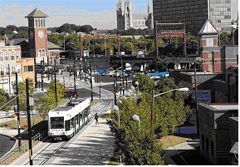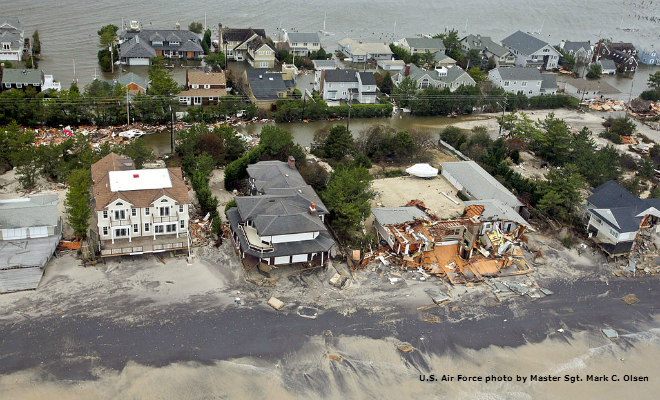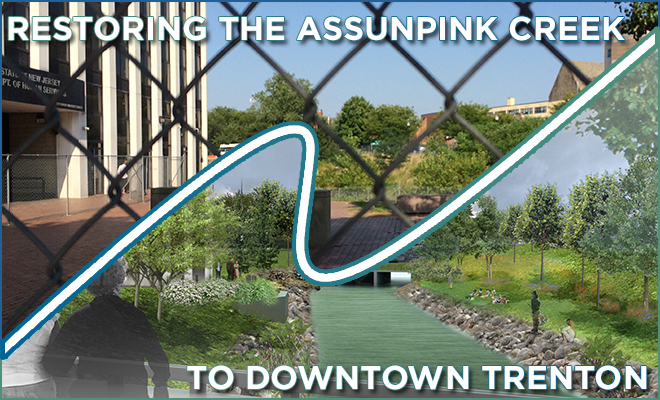New Jersey Future Blog
EPA Study Finds Redevelopment Taking Hold Nationwide, What About NJ?
March 30th, 2010 by Jay Corbalis

Newark Broad St. Station and Light Rail. Source: Transit Friendly Development Newsletter Vol. 4 Num. 2
A recent study by the Environmental Protection Agency finds that redevelopment is becoming the dominant paradigm for residential growth in urban areas. The study, titled Residential Construction Trends in America’s Metropolitan Regions, looks at 19 years of building permit data, from 1990 to 2008, in the 50 largest metropolitan areas in the country. In roughly half of those regions, the study found that building permits issued in the central city increased dramatically as a share of total building permits issued in the region. Interestingly, the study also found that this trend intensified in recent years during the real estate downturn, suggesting that urban markets may be holding their value better than their suburban counterparts.
Within the study, the picture for NJ is mixed. Because the study looks only at metropolitan areas, it covers NJ only to the extent that most of the state is within either the Philadelphia or New York metropolitan area. However, a closer look at urban areas in NJ finds that they too account for an increasingly larger share of total building permits in the state over the past 19 years. The eight “urban centers” [Newark, Jersey City, Paterson, Elizabeth, Trenton, Camden, New Brunswick, Atlantic City] identified by New Jersey’s State Plan accounted for only 3 percent of total statewide residential building permits for the 1990-1995 time period but 14 percent of permits for the 2003-2008 period.
This data seems to confirm the trends that Jeffrey Outteau highlighted in his keynote address at New Jersey Future’s Redevelopment Forum. An increasing number of ‘single’ households, shifting market preferences towards walkable neighborhoods, and the large number of transit-oriented development opportunities thanks to its extensive rail network all combine to give NJ a distinct advantage in a redevelopment based housing market. But we better move fast. If the new EPA study is any indication, the rest of the nation may finally be catching on to NJ’s smart growth ways. Stay tuned for more on this subject in our upcoming Future Facts!
‘Smart Growth’ Taking Hold in U.S. Cities, Study Says (New York Times)

















I am dismayed but not surprised that most assessments of New Jersey’s smart growth policies leave out Monmouth and Ocean. While they may be in the no-man’s land between the Philadelphia and New York analysis areas, this area is one of the fastest growing in the state if not the region. If there is any region of New Jersey that the rest of the United States is catching up on in the drive for smart growth, it is the Jersey Shore.
There needs to be more attention called to the main obstacles to smart growth in this region: fragmented local governments, an emphasis on cars, and a closed-door approach to development. The county’s 53 towns are warring over development and stuck in suburban logic rather than collaborating on regional initiatives to direct growth in a sustainable way. The county has done little to promote sidewalks and bike lanes outside of the Asbury Park-Long Branch corridor, primarily due to the lack of local agitation elsewhere. Finally, the design process for most new development tends to take place behind closed doors with public input as an afterthought. This only encourages more hostility toward higher density, which actually promotes more functional communities if implemented in concert with good planning procedures.
However, I do believe that change is coming. A coalition has been started in Red Bank to push for more walkable streets. On a broader scale, I think that the cuts in municipal aid promised by Christie will spur consolidation of government structure. The larger an area each city hall oversees, the less room there will be for myopic, parochial interests. Whether Christie will stick to his guns and whether local leaders will bury the hatchet, only time will tell.
Wow, what a spin-site. Does it occur to you that your conclusion that ‘centers of cities seem to be holding their value’ is an illusion resulting from government subsidies of smart growth?
When redevelopment agencies declare city centers blighted (not even necessary in much of the country) they are then free to demolish existing buildings and haul them to a landfill. Diverting property tax dollars from general funds, police and fire, schools, and roads to the pockets of bond brokers for 30-45 years is not sustainable. This is social engineering, a fad, and worse than that. New urbanism is a failure.
How many of you live in a condo next to a bus line? Loss of privacy and subjugation to a condo board or HOA is not the way most people want to live. If smart growth were desirable it wouldn’t require major subsidies—it never pencils out. Where are all of these subsidies supposed to come from? Strangling communities with hundreds of condos that become apartments (after the bankruptcies), and failed retail insures that the promise of high property taxes will collapse.
Living the SmartGrowth UN Agenda 21 ideology is an unsustainable fantasy that will be a nightmare if you continue to legislate it.
See Democrats Against UN Agenda 21 dot com for more information on Redevelopment, the vampire that never dies, and SmartGrowth, vertical sprawl.